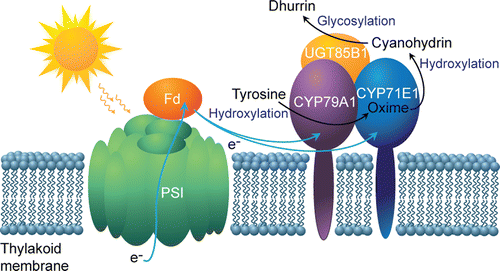Advance in re-engineering photosynthesis to make drugs, compounds or ingredients

Scientists are reporting an advance in re-engineering photosynthesis to transform plants into bio-factories that manufacture high-value ingredients for medicines, fabrics, fuels and other products. They report on the research in the journal ACS Synthetic Biology.
Poul Erik Jensen and colleagues explain that photosynthesis does more than transform carbon dioxide and water into sugar and oxygen and generate energy. That process also produces a wealth of natural chemical compounds, many of which have potential uses in medicines and other commercial products. However, evolution has compartmentalized those functions into two separate areas of plant cells. Chloroplasts, the packets of chlorophyll that make plants green, generate energy and produce sugar and oxygen. Another structure, the endoplasmic reticulum, produces a wide range of natural chemicals.
Their report describes breaking that evolutionary compartmentalization by relocating an entire metabolic pathway needed for production of natural bioactive chemicals to the chloroplast. "This opens the avenue for light-driven synthesis of a vast array of other natural chemicals in the chloroplast," they say, citing key natural chemicals that would be ingredients in medications.

The article is titled "Redirecting Photosynthetic Reducing Power towards Bioactive Natural Product Synthesis."
More information: Redirecting Photosynthetic Reducing Power toward Bioactive Natural Product Synthesis, DOI: 10.1021/sb300128r
Abstract
In addition to the products of photosynthesis, the chloroplast provides the energy and carbon building blocks required for synthesis of a wealth of bioactive natural products of which many have potential uses as pharmaceuticals. In the course of plant evolution, energy generation and biosynthetic capacities have been compartmentalized. Chloroplast photosynthesis provides ATP and NADPH as well as carbon sources for primary metabolism. Cytochrome P450 monooxygenases (P450s) in the endoplasmic reticulum (ER) synthesize a wide spectrum of bioactive natural products, powered by single electron transfers from NADPH. P450s are present in low amounts, and the reactions proceed relatively slowly due to limiting concentrations of NADPH. Here we demonstrate that it is possible to break the evolutionary compartmentalization of energy generation and P450-catalyzed biosynthesis, by relocating an entire P450-dependent pathway to the chloroplast and driving the pathway by direct use of the reducing power generated by photosystem I in a light-dependent manner. The study demonstrates the potential of transferring pathways for structurally complex high-value natural products to the chloroplast and directly tapping into the reducing power generated by photosynthesis to drive the P450s using water as the primary electron donor.
Journal information: ACS Synthetic Biology
Provided by American Chemical Society















